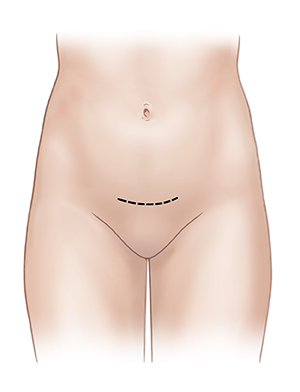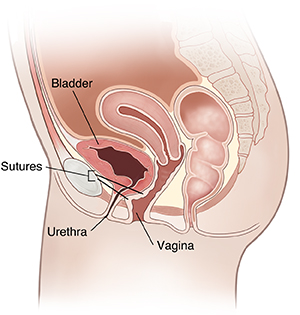Stress Urinary Incontinence: Having Retropubic Suspension Surgery
To help treat stress urinary incontinence (SUI), your surgeon may do a procedure called retropubic suspension. It is done by making a cut in the lower part of your belly (abdomen). During this surgery, the surgeon puts stitches through the tissue next to the vagina. This is to help support the urethra and bladder firmly in place. It helps keep the urethra closed to prevent urine leakage. Your surgery will take about 2 hours. You will be asked to do some things at home to get ready for surgery. Below are guidelines to help you get ready. If you have any questions, call your nurse or healthcare provider.
How should I get ready for surgery?
The weeks before surgery
-
Have any tests that your healthcare provider orders.
-
Tell your provider about any prescription and over-the-counter medicines, vitamins, supplements, or herbs you take. Ask if you should stop taking them before surgery.
-
Stop smoking to help reduce your risks during surgery.
-
If you have been given any prescriptions to fill, do this before surgery.
The night before surgery
-
You may be asked to give yourself an enema. This cleans out your bowels for surgery. You’ll be told how to do it.
-
Follow any directions you are given for taking medicines.
-
Follow any directions for not eating or drinking before surgery.
The day of surgery
Get to the hospital a few hours before surgery as directed. Have someone drive you there who can also stay during the surgery and drive you home. At the hospital, you will be asked to sign a consent form. This gives your permission to do the procedure. Read the form carefully. Have all your questions answered before you sign it.
Your temperature and blood pressure will be taken. In some cases, tests may be done. Then one or more IV (intravenous) lines will be placed in your hand or arm. These lines give you fluids and medicines before, during, and after surgery. Some of your pubic hair may be shaved. Tight stockings (compression stockings) may be put on your legs. This is to help prevent blood clots.
About anesthesia
To keep you pain-free during surgery, you’ll be given anesthesia. General anesthesia allows you to comfortably sleep. Regional anesthesia numbs the lower part of your body. Local anesthesia numbs the area that will be operated on. Before surgery, you’ll meet with the anesthesiologist or nurse anesthetist. They will ask about your health history and tell you what kind of anesthesia you will have. They will answer any questions you may have.
What happens during the surgery?
-
A cut (incision) about 4 inches long is made in the lower part of the belly, near the pubic hairline.
-
Through the incision, the surgeon places stitches into the tissue next to the vagina. Or stitches may be placed into the outside walls of the vagina behind the urethra. The ends of the stitches are tied to strong tissues or bone nearby.
-
The incision is closed with stitches, staples, or strips of tape.
 |
| An incision is made in your lower belly. |

What are the risks and possible complications?
All procedures have risks. Some possible risks of this procedure include:
-
Infection
-
Bleeding
-
Risks of anesthesia
-
Blood clots
-
Damage to nerves, muscles, bladder, or nearby pelvic structures
-
Trouble urinating
-
Sudden urge to urinate
-
The surgery doesn't reduce your symptoms